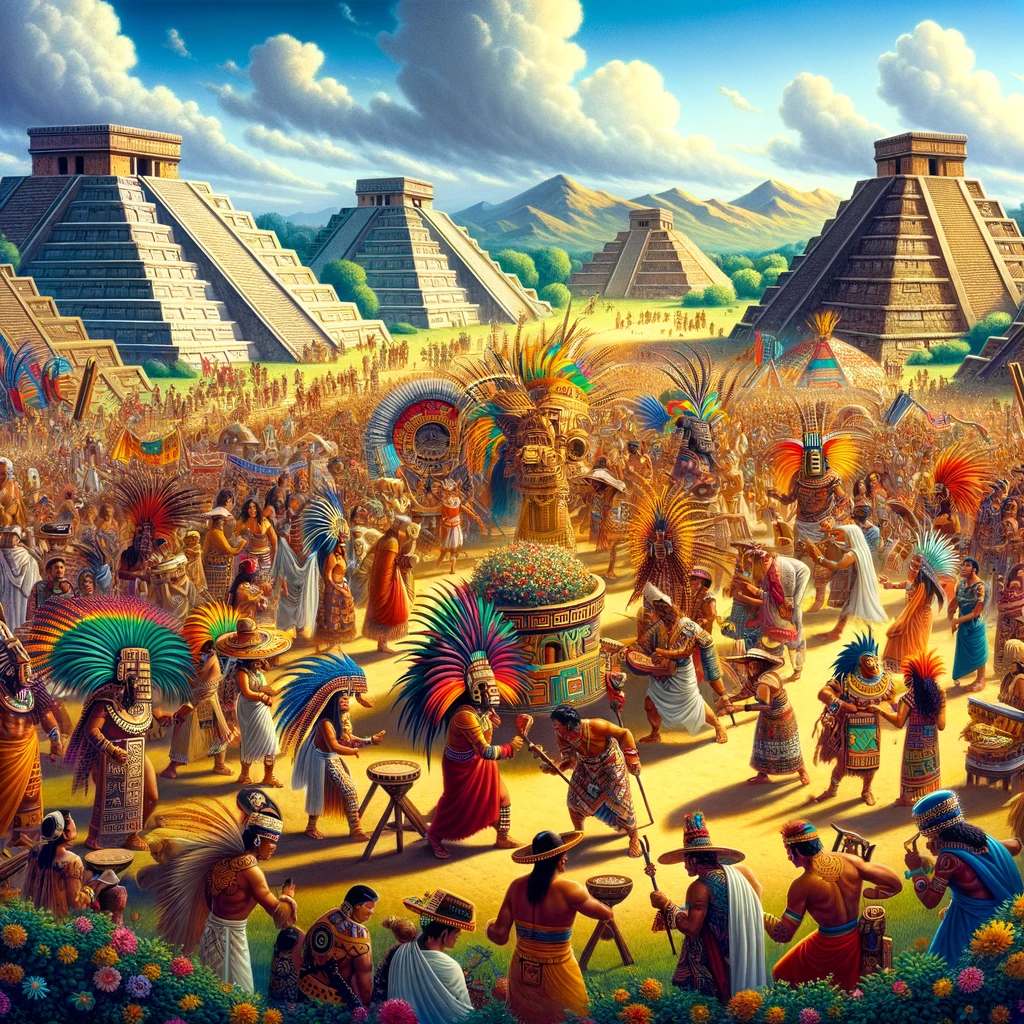
The Aztec civilization, one of the most eminent pre-Columbian cultures of Mesoamerica, was not only known for its architectural and mathematical achievements but also for its rich religious practices and elaborate festivals. Among these, Etzalcualiztli stands out as a significant celebration that pays homage to agriculture, fertility, and the sustenance provided by the earth. This festival, dedicated primarily to the maize deity Centéotl and Tlaloc, the god of rain, illustrates the intricate relationship the Aztecs had with nature and their deep-seated beliefs in the cyclical processes of life and renewal.
Timing and Significance
Etzalcualiztli, which translates to "eating of maize and beans," occurred during the fourth month of the Aztec solar calendar, roughly aligning with the end of May and the beginning of June in the Gregorian calendar. This period marks the onset of the rainy season, crucial for agriculture, especially for the cultivation of maize, the staple food of the Aztecs. The timing of the festival was meticulously chosen to coincide with the critical phase of maize cultivation, underscoring the importance of this crop in the sustenance and culture of the Aztec people.
Ceremonies and Rituals
The festival was characterized by a series of rituals and ceremonies aimed at ensuring a bountiful harvest. One of the central figures in these celebrations was Centéotl, the maize god, who was believed to oversee the growth and health of the maize crops. Priests and devotees offered prayers, performed dances, and made sacrifices to honor Centéotl, seeking his blessings for a prosperous growing season. Similarly, Tlaloc, the rain god, was propitiated with offerings and ceremonies to ensure adequate rainfall for the crops.
The celebrations also included a communal aspect, with feasts and music bringing the community together. People would gather to share food, often dishes made from the first harvest of maize, symbolizing the fertility of the earth and the generosity of the gods. These communal feasts fostered a sense of unity and gratitude among the participants, reinforcing the social bonds within the community.
Symbolism and Legacy
Etzalcualiztli was more than just a plea for a good harvest; it was a testament to the Aztec understanding of the interconnectedness of the cosmos, the earth, and human society. The festival symbolized the reciprocal relationship between the people and their gods, where human offerings and rituals were believed to sustain the divine beings who, in turn, ensured the fertility of the earth.
The legacy of Etzalcualiztli, and other Aztec festivals, continues to influence contemporary Mexican culture, with elements of these ancient celebrations still present in modern-day festivals. These events serve as a reminder of the rich heritage of the Aztec civilization and its enduring influence on the identity and traditions of Mexico.
In conclusion, Etzalcualiztli was a vital component of the Aztec religious calendar, embodying the civilization's reverence for nature, its cycles, and the gods who presided over them. This festival highlights the Aztecs' sophisticated understanding of agriculture, their deep spiritual connection to the earth, and the importance of community and gratitude in their society. Through the lens of Etzalcualiztli, we gain insight into the complexity and richness of Aztec culture, a civilization that continues to fascinate and inspire.
Timing and Significance
Etzalcualiztli, which translates to "eating of maize and beans," occurred during the fourth month of the Aztec solar calendar, roughly aligning with the end of May and the beginning of June in the Gregorian calendar. This period marks the onset of the rainy season, crucial for agriculture, especially for the cultivation of maize, the staple food of the Aztecs. The timing of the festival was meticulously chosen to coincide with the critical phase of maize cultivation, underscoring the importance of this crop in the sustenance and culture of the Aztec people.
Ceremonies and Rituals
The festival was characterized by a series of rituals and ceremonies aimed at ensuring a bountiful harvest. One of the central figures in these celebrations was Centéotl, the maize god, who was believed to oversee the growth and health of the maize crops. Priests and devotees offered prayers, performed dances, and made sacrifices to honor Centéotl, seeking his blessings for a prosperous growing season. Similarly, Tlaloc, the rain god, was propitiated with offerings and ceremonies to ensure adequate rainfall for the crops.
The celebrations also included a communal aspect, with feasts and music bringing the community together. People would gather to share food, often dishes made from the first harvest of maize, symbolizing the fertility of the earth and the generosity of the gods. These communal feasts fostered a sense of unity and gratitude among the participants, reinforcing the social bonds within the community.
Symbolism and Legacy
Etzalcualiztli was more than just a plea for a good harvest; it was a testament to the Aztec understanding of the interconnectedness of the cosmos, the earth, and human society. The festival symbolized the reciprocal relationship between the people and their gods, where human offerings and rituals were believed to sustain the divine beings who, in turn, ensured the fertility of the earth.
The legacy of Etzalcualiztli, and other Aztec festivals, continues to influence contemporary Mexican culture, with elements of these ancient celebrations still present in modern-day festivals. These events serve as a reminder of the rich heritage of the Aztec civilization and its enduring influence on the identity and traditions of Mexico.
In conclusion, Etzalcualiztli was a vital component of the Aztec religious calendar, embodying the civilization's reverence for nature, its cycles, and the gods who presided over them. This festival highlights the Aztecs' sophisticated understanding of agriculture, their deep spiritual connection to the earth, and the importance of community and gratitude in their society. Through the lens of Etzalcualiztli, we gain insight into the complexity and richness of Aztec culture, a civilization that continues to fascinate and inspire.